Link
The Neo-Ticketing project is up for an award at the Ticketing Technology Awards in Dublin, April 2016!
Please help us out and vote for us by following this link 😊
2 notes
·
View notes
Link
You can download the full, final report on the Neo-Ticketing project direct from the Digital R&D Fund for the Arts website here.
#ticketing#arts#culture#events#box office#software#dynamic pricing#the digital r&d fund for the arts#firestation arts
1 note
·
View note
Text
Moving Prices Experiment Summary
In the Winter season (Jan to Apr 2015), a more sophisticated dynamic ticket pricing mechanism was put in place. Two variants were in place, to be analogous to the +/-25% and +/-50% schemes of Rising Prices in the previous season. In one variant, to be denoted D25, four bands were constructed showing for each day in the sales period where cumulative sales stood relative to anticipated values. The region in which sales lay determined whether the tickets were sold at base price, or discounted by 15% or 25%, or surcharged by 15% or 25%. In the other variance, denoted D50, the same principle applied, but with discounts of 25% or 50%, or surcharges of 25% and 50%. There were 8 shows in the D25 category, and 13 in the D50 category.
Of the 21 shows, 7 generated no price changes over the sales period; 11 showed prices that fell below base (but were never above); none were risen above base (but never below); while 3 showed prices both above and below base.
The price adjustment mechanism was based upon eyeball projections of anticipated sales. In retrospect, this was clearly anticipating too optimistic a sales pattern, meaning that a typical show would - in the early sales period - display under-achievement leading to a price fall.
The over-optimistic prediction of likely early sales, had a detrimental impact on the performance of events under the +/-25% and +/-50% Moving Pricing schemes, with 52% of shows only lowering in price and 86% remaining either at or below the core price.
The performance of the entire scheme may well have been markedly different had the Sell Out, Early, Steady and Late sales curve been closer aligned to actual sales and therefore it would be sensible to recommend that true, automated dynamic pricing - as with Moving Prices - only be deployed where considerable time has been spent using historical sales patterns to inform the dynamic pricing algorithms.
Within the scope of the results included here, it also seems that with a low (.13) elasticity of demand, the fall in price triggered in the box office platform only served to decrease revenues, with no significant beneficial increase in demand. As suggested above, it may be concluded that an upward only Moving Prices scheme may be more productive - and safer - for venues like The Firestation.
That being said, over the course of the January to April events season, the Moving Prices +/-25% and +/50% schemes had no overall detrimental effect on either prices or revenues. It is quite possible that, with predicted sales patterns tailored from the above results, or upward only models, Moving Prices with modest ranges could produce a more positive result in both revenue and audience numbers.
For full details please see the Neo-Ticketing Final Report (link to follow)
#neo-ticketing#ticketing#box office#pricing#dynamic pricing#the digital r&d fund for the arts#firestation arts
1 note
·
View note
Text
Price Crash Experiment Results
During the Winter season 2015, in addition to the Moving Prices +/-25% and +/-50% schemes, there were ‘random price crashes’. In these, the box office system would discount the current price for a show by 75% – for 30 minutes only, to be announced via The Firestation’s social media channels. The price crash idea was as much about generating excitement about the experiment and encouraging sharing and new likes on social media channels, as it was to actually impact upon ticket sales and revenue. Note however that, given that sell-outs are rare, even sales at 75% off will raise revenue if these customers would not otherwise buy tickets to that show.
Although its number of followers moves up and down all the time, The Firestation has been active on Facebook and Twitter for a number of years and during the project time-frame had approximately 2,500 followers on Twitter and 2,800 likes on Facebook.
In order to ensure that Price Crash occurrences were entirely random, all events in the January to April season were run through a ‘dice roll’ process. In the first instance, it was established whether and event would have one, two, three or no Price Crashes. If the result came up one too three, then each occurrence was randomly selected by month, date and time.
Whilst much discussion was had on the length of the crash and at what times these should occur, it was decided that crashes should occur only between 08:00 and 01:00 and last no longer than 30 minutes (to generate a sense of urgency).
These price crashes were then manually set up on the box office system using the “ability to manually add new dynamic calculation rules” outlined above in the ‘Building the Code’ chapter. Scheduled posts on Facebook and scheduled tweets on Twitter were then set up on both platforms to post at the same time as the price dropped on the box office. An example of such a post - for Wind in the Willows can be seen below;
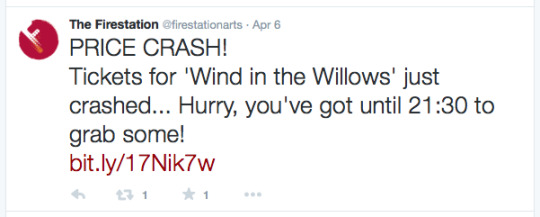
Sales Results
Disappointingly, and to everyone’s surprise, the Price Crash experiments resulted in no sales. Whilst a small number of the early tweets failed (an issue with scheduled posts from Facebook not transferring to Twitter and Twitter Ads rejecting multiple posts with the same copy), the majority posted successfully and were matched with successful price crashes on the box office.
Whilst it is difficult to speculate on the reason for the lack of uptake, it seems likely that it is the result of 4 factors;
That 30 minutes is not long enough for potential customers to digest the information, take time away from whatever else they were doing, or contact friends to arrange tickets and/or availabilities.
That the price crashes suffered from the same effect outlined above in the Rising Prices Results & Analysis conclusion, where customers were reluctant to purchase heavily discounted tickets, preferring instead to support the venue with higher price tickets.
That the Price Crash creates a negative impression in the customers mind, suggesting that ticket sales are slow or that the show is of poor quality.
That the ‘Price Crash’ idea will take longer to ‘bed in’ and be adopted by regular customers and social media followers than the 4 months studied here.
Analytics Results
With no sales results to examine, it was still possible to look at web traffic and analytics, to see if the Price Crash posts performed better than other posts on the venue’s social media platforms. For examples, whilst there were no sales, was a Price Crash tweet re-tweeted more often than others on the same day, or was a Facebook post liked above average?
In fact, as they are the price crashes appear to have an overall similar impact as a normal post. There is nothing to suggest they increase (or decrease activity).
The charts below show the performance by month of both Price Crash and normal tweets and posts on both platforms;


#dynamic pricing#nesta#digital r&d fund for the arts#ticketing#Social media#analytics#the firestation
0 notes
Text
Supa-Quick Stats, Phase 2 ‘Moving Prices’ (with comparison)
.tg {border-collapse:collapse;border-spacing:0;} .tg td{font-family:Arial, sans-serif;font-size:14px;padding:10px 5px;border-style:solid;border-width:1px;overflow:hidden;word-break:normal;} .tg th{font-family:Arial, sans-serif;font-size:14px;font-weight:normal;padding:10px 5px;border-style:solid;border-width:1px;overflow:hidden;word-break:normal;} .tg .tg-hy62{background-color:#c0c0c0} .tg .tg-8xqh{font-weight:bold;background-color:#c0c0c0}
Jan-Apr 15
(Neo Moving) Sep-Dec 14
(Neo Rising) May-Aug 14 Jan-Apr 14 Sep-Dec 13 # events 22 25 49 78 64 Ave Attendance 47 33 24 34 61 Ave Core Price* 8.80 9.00 - - - Ave Net Price 8.46 10.50 9.01 9.67 10.46
* The fixed price we would normally have set, and the price the dynamic price ranges above and below.
Note; November & December 2013 included an unusually high number of sell out comedy shows, which has caused some distortion in the average attendance.
#neo-ticketing#the digital r&d fund for the arts#monad ticketing#box office#event#sales#dynamic pricing#software#tech#theatre
0 notes
Text
Writing the Code
By Ben Curthoys
Part of the problem with dynamic pricing - and this is the general problem with writing any code at all, really - is that making it do only one thing is easy. The first set of dynamic price schemes that we wanted to test were very simple: the prices went up every day, no matter what. With a system like that, taking a request like;
"Make the prices go from 25% off to 25% extra over the course of the 50 days before the performance"
would result in some code that would say;
"At any point in time the adjustment should be (25 minus the number of days until the performance) percent."
Simple. We don't need to store long and elaborate histories of prices, and we don't need to know what we were doing yesterday to calculate what we're doing today; the algorithm is entirely deterministic.
Of course, I knew that after we'd tested simple rising prices, the next step would be to test a more sophisticated price scheme that went up and down according to demand. But we'd be modelling that relatively simply as well (if total sales were between X% and Y% set the adjustment to Z%), so there was a tempation to just build two completely different dynamic price models and call it a day.
The trouble is, when someone dreams up a third - and a fourth, and a fifth - you have to keep adding more and more code, and it gets gradually harder to explain and train people to use and to maintain. The ideal solution is to have just one dynamic price system that works for all the models we can think of - and all the ones that we haven't thought of yet, too.
The solution we arrived at was a rules based one. Each price scheme could have a number of rules, of the form
If (condition has happened) then (change the price by £X)|(set the price to £Y)
This means that we can express the simple, rising prices as
If (anything) then (put the price up by 1%)
and we can express the dynamic prices by saying
If (we've sold fewer tickets than we expected) then (set the price to 25% off)
If (we've sold roughly as many tickets as we expected) then (set the price to the default)
If (we've sold more tickets than we expected) then (set the price to 25% extra)
and we can even express more sophisticated schemes by saying
If (we've sold loads of tickets in the last 30 minutes) then (nudge the price up a bit based on what it was)
If (we've sold no of tickets in weeks) then (drop the price down a bit)
(though we're not even testing that last one in this project because the results will be too hard to analyse.)
So here's the code that goes through all the products using a dynamic price scheme, and updates their adjustments based on which rules are matched:
IF EXISTS (SELECT * FROM sys.objects WHERE object_id = OBJECT_ID(N'[dbo].[spPriceSchemeDynamic_UPDATEPRODUCTS]') AND type in (N'P', N'PC'))
DROP PROCEDURE [dbo].spPriceSchemeDynamic_UPDATEPRODUCTS
GO
CREATE PROCEDURE spPriceSchemeDynamic_UPDATEPRODUCTS (@PriceSchemeId as uniqueidentifier)
AS
DECLARE @DynamicAmount money; DECLARE @DynamicPercentage decimal(5, 4); DECLARE @DynamicRounding money; DECLARE @DynamicMin money; DECLARE @DynamicMax money; DECLARE @DynamicChangeAmount money
DECLARE @DynamicChangePercentage decimal(5, 4);DECLARE @DynamicChangeRounding money;DECLARE @DynamicChangeMin money; DECLARE @DynamicChangeMax money
DECLARE @DynamicTotalChangeAmount money;DECLARE @DynamicTotalChangePercentage decimal(5, 4) ;DECLARE @DynamicTotalChangeRounding money ;DECLARE @DynamicTotalChangeMin money ;DECLARE @DynamicTotalChangeMax money
DECLARE @DynamicSetAmount bit;DECLARE @StartSourceDateType nvarchar(50) ;DECLARE @StartOffset bigint ;DECLARE @EndSourceDateType nvarchar(50) ;DECLARE @EndOffset bigint ;DECLARE @SampleDurationTicks bigint ;DECLARE @SampleMinTickets int ;DECLARE @SampleMaxTickets int ;DECLARE @SampleMinTicketsFunction nvarchar(255);DECLARE @SampleMaxTicketsFunction nvarchar(255)
DECLARE curPriceSchemeDynamicRules CURSOR LOCAL DYNAMIC FOR
SELECT DynamicChangeAmount,
DynamicChangePercentage,
DynamicChangeRounding,
DynamicChangeMin,
DynamicChangeMax,
StartSourceDateType,
StartOffset,
EndSourceDateType,
EndOffset,
SampleDurationTicks,
SampleMinTickets,
SampleMaxTickets,
DynamicSetAmount,
SampleMinTicketsFunction,
SampleMaxTicketsFunction
FROM PriceSchemeDynamicRules
WHERE PriceSchemeId = @PriceSchemeId
OPEN curPriceSchemeDynamicRules
DECLARE @ProductId uniqueidentifier
DECLARE @PerfStartDateTime DATETIME
DECLARE @PerfEndDateTime DATETIME
DECLARE @ShowStartDate DATE
DECLARE @ShowEndDate DATE
DECLARE @OldProductDynamicPriceCalculationId uniqueidentifier
DECLARE curProductDynamicData CURSOR STATIC LOCAL FOR
SELECT
Products.ProductId,
FolderPerformanceData.StartDateTimeUTC, FolderPerformanceData.EndDateTimeUTC,
FolderShowData.ShowStartDate, FolderShowData.ShowEndDate,
ProductDynamicPriceCalculationId,
DynamicAmount, DynamicPercentage, DynamicRounding, DynamicMin, DynamicMax
FROM
Products
INNER JOIN ProductsActive ON Products.ProductId = ProductsActive.ProductId
INNER JOIN FolderDataCache ON Products.FolderId = FolderDataCache.FolderId
INNER JOIN PriceSchemeDynamic ON Products.PriceSchemeId = PriceSchemeDynamic.PriceSchemeId
LEFT JOIN ProductDynamicPriceCalculation ON Products.ProductId = ProductDynamicPriceCalculation.ProductId
LEFT JOIN FolderShowData ON FolderDataCache.ShowFolderId = FolderShowData.ShowFolderId
LEFT JOIN FolderPerformanceData ON FolderDataCache.PerformanceFolderId = FolderPerformanceData.PerformanceFolderId
WHERE Products.PriceSchemeId = @PriceSchemeId AND ProductDynamicPriceCalculation.ActiveTo IS NULL
OPEN curProductDynamicData
FETCH NEXT FROM curProductDynamicData INTO @ProductId, @PerfStartDateTime, @PerfEndDateTime, @ShowStartDate, @ShowEndDate, @OldProductDynamicPriceCalculationId, @DynamicAmount, @DynamicPercentage, @DynamicRounding, @DynamicMin, @DynamicMax
WHILE @@FETCH_STATUS = 0
BEGIN
-- Reset the total changes
SELECT @DynamicTotalChangeAmount = NULL, @DynamicTotalChangePercentage = NULL, @DynamicTotalChangeRounding = NULL, @DynamicTotalChangeMin = NULL, @DynamicTotalChangeMax = NULL
-- PRINT 'ProductId ' + ISNULL(CONVERT(nvarchar(255), @ProductId), 'null')
FETCH FIRST FROM curPriceSchemeDynamicRules INTO @DynamicChangeAmount, @DynamicChangePercentage, @DynamicChangeRounding, @DynamicChangeMin, @DynamicChangeMax, @StartSourceDateType, @StartOffset, @EndSourceDateType, @EndOffset, @SampleDurationTicks, @SampleMinTickets, @SampleMaxTickets, @DynamicSetAmount, @SampleMinTicketsFunction, @SampleMaxTicketsFunction
WHILE @@FETCH_STATUS = 0
BEGIN
-- PRINT '------------------'
-- PRINT 'Rule ' + CONVERT(NVARCHAR(255), @DynamicChangePercentage)
-- PRINT 'Performance Date ' + CONVERT(NVARCHAR(255), @PerfStartDateTime)
-- If this performance matches this rule, then modify the Dynamic Data by the amounts specified
DECLARE @doUpdate bit = 1
IF NOT EXISTS (
SELECT 1 FROM
(
SELECT
CASE @StartSourceDateType
WHEN 'NONE' THEN NULL
WHEN 'EXACT' THEN dbo.fnTicksToDate(@StartOffset)
WHEN 'SHOWSTART' THEN DATEADD(s, @StartOffset * POWER(10.00000000000,-7), COALESCE(@ShowStartDate, @PerfStartDateTime))
WHEN 'SHOWEND' THEN DATEADD(s, @StartOffset * POWER(10.00000000000,-7), COALESCE(DATEADD(minute, -1, DATEADD(day, 1, @ShowEndDate)), @PerfEndDateTime))
WHEN 'PERFSTART' THEN DATEADD(s, @StartOffset * POWER(10.00000000000,-7), COALESCE(@PerfStartDateTime, @ShowStartDate))
WHEN 'PERFEND' THEN DATEADD(s, @StartOffset * POWER(10.00000000000,-7), COALESCE(@PerfEndDateTime, @ShowStartDate))
WHEN 'PERFSTARTDATE' THEN DATEADD(s, @StartOffset * POWER(10.00000000000,-7), dbo.fnDateOnly(COALESCE(@PerfStartDateTime, @ShowStartDate)))
WHEN 'PERFENDDATE' THEN DATEADD(s, @StartOffset * POWER(10.00000000000,-7), dbo.fnDateOnly(COALESCE(@PerfEndDateTime, @ShowStartDate)))
END AS StartDateTime,
CASE @EndSourceDateType
WHEN 'NONE' THEN NULL
WHEN 'EXACT' THEN dbo.fnTicksToDate(@EndOffset)
WHEN 'SHOWSTART' THEN DATEADD(s, @EndOffset * POWER(10.00000000000,-7), COALESCE(@ShowStartDate, @PerfStartDateTime))
WHEN 'SHOWEND' THEN DATEADD(s, @EndOffset * POWER(10.00000000000,-7), COALESCE(DATEADD(minute, -1, DATEADD(day, 1, @ShowEndDate)), @PerfEndDateTime))
WHEN 'PERFSTART' THEN DATEADD(s, @EndOffset * POWER(10.00000000000,-7), COALESCE(@PerfStartDateTime, DATEADD(minute, -1, DATEADD(day, 1, @ShowEndDate))))
WHEN 'PERFEND' THEN DATEADD(s, @EndOffset * POWER(10.00000000000,-7), COALESCE(@PerfEndDateTime, DATEADD(minute, -1, DATEADD(day, 1, @ShowEndDate))))
WHEN 'PERFSTARTDATE' THEN DATEADD(s, @EndOffset * POWER(10.00000000000,-7), dbo.fnDateOnly(COALESCE(@PerfStartDateTime, DATEADD(minute, -1, DATEADD(day, 1, @ShowEndDate)))))
WHEN 'PERFENDDATE' THEN DATEADD(s, @EndOffset * POWER(10.00000000000,-7), dbo.fnDateOnly(COALESCE(@PerfEndDateTime, DATEADD(minute, -1, DATEADD(day, 1, @ShowEndDate)))))
END AS EndDateTime
) AS ConcreteDates
WHERE
(GETDATE() > StartDateTime OR StartDateTime IS NULL) AND
(GETDATE() < EndDateTime OR EndDateTime IS NULL)
)
BEGIN
SET @doUpdate = 0
END
IF (@SampleMinTickets IS NOT NULL OR @SampleMinTicketsFunction IS NOT NULL OR @SampleMaxTickets IS NOT NULL OR @SampleMaxTicketsFunction IS NOT NULL)
BEGIN
DECLARE @SampleTicketsSold INT
SET @SampleTicketsSold = (SELECT COUNT(*) FROM Items INNER JOIN OrderItems ON Items.ItemId = OrderItems.ItemId INNER JOIN Orders ON OrderItems.OrderId = Orders.OrderId WHERE Items.ProductId = @ProductId AND (NULLIF(@SampleDurationTicks, 0) IS NULL OR OrderDate > DATEADD(s, -1 * @SampleDurationTicks * POWER(10.00000000000,-7), GETDATE())))
IF @SampleMaxTicketsFunction IS NOT NULL OR @SampleMaxTicketsFunction IS NOT NULL
BEGIN
-- Just get earliest date - no matter what permissions are attached.
DECLARE @OnSaleDateTime DATETIME =
(
SELECT
MIN(
CASE StartSourceDateType
WHEN 'EXACT' THEN dbo.fnTicksToDate(StartOffset)
WHEN 'SHOWSTART' THEN DATEADD(s, StartOffset * POWER(10.00000000000,-7), COALESCE(@ShowStartDate, @PerfStartDateTime))
WHEN 'SHOWEND' THEN DATEADD(s, StartOffset * POWER(10.00000000000,-7), COALESCE(DATEADD(minute, -1, DATEADD(day, 1, @ShowEndDate)), @PerfEndDateTime))
WHEN 'PERFSTART' THEN DATEADD(s, StartOffset * POWER(10.00000000000,-7), COALESCE(@PerfStartDateTime, @ShowStartDate))
WHEN 'PERFEND' THEN DATEADD(s, StartOffset * POWER(10.00000000000,-7), COALESCE(@PerfEndDateTime, @ShowStartDate))
END) AS StartDateTime
FROM
OnSaleSchemeValues
INNER JOIN Products ON Products.OnSaleSchemeId = OnSaleSchemeValues.OnSaleSchemeId
WHERE
Products.ProductId = @ProductId
)
-- If there are no dates, get the date it was activated
IF (@OnSaleDateTime = '1900-01-01' OR @OnSaleDateTime IS NULL)
SET @OnSaleDateTime = (SELECT ActivatedDateTime FROM ProductsActive WHERE ProductId = @ProductId)
-- PRINT 'On Sale Date ' + CONVERT(Nvarchar(255), @OnSaleDateTime)
DECLARE @TotalCapacity INT = (SELECT COUNT(*) FROM Items WHERE ProductId = @ProductId)
-- PRINT 'Total Capacity ' + CONVERT(Nvarchar(255), @TotalCapacity)
IF (NULLIF(@SampleMinTicketsFunction, '') IS NOT NULL)
BEGIN
SELECT @SampleMinTickets = dbo.fnDynamicExpectedSalesCount(@SampleMinTicketsFunction, @OnSaleDateTime, @PerfStartDateTime, @TotalCapacity)
END
IF (NULLIF(@SampleMaxTicketsFunction, '') IS NOT NULL)
BEGIN
SELECT @SampleMaxTickets = dbo.fnDynamicExpectedSalesCount(@SampleMaxTicketsFunction, @OnSaleDateTime, @PerfStartDateTime, @TotalCapacity)
END
END
-- PRINT 'Rule Min: ' + ISNULL(CONVERT(nvarchar(255), @SampleMinTickets), 'null')
-- PRINT 'Rule Max: ' + ISNULL(CONVERT(nvarchar(255), @SampleMaxTickets) , 'null')
-- PRINT 'Actual: ' + ISNULL(CONVERT(nvarchar(255), @SampleTicketsSold) , 'null')
IF (@SampleMinTickets IS NOT NULL AND @SampleTicketsSold <= @SampleMinTickets)
SET @doUpdate = 0
IF (@SampleMaxTickets IS NOT NULL AND @SampleTicketsSold >= @SampleMaxTickets)
SET @doUpdate = 0
IF (@SampleMinTickets = @SampleMaxTickets)
SET @doUpdate = 0
END
IF @doUpdate = 1
BEGIN
-- PRINT 'Doing Update'
IF @DynamicSetAmount = 1
BEGIN
-- Just set the base values
SELECT
@DynamicAmount = @DynamicChangeAmount,
@DynamicPercentage = @DynamicChangePercentage,
@DynamicRounding = @DynamicChangeRounding,
@DynamicMin = @DynamicChangeMin,
@DynamicMax = @DynamicChangeMax
END
ELSE
BEGIN
-- Add this record to the change
SELECT
@DynamicAmount = COALESCE(@DynamicAmount + @DynamicChangeAmount, @DynamicAmount, @DynamicChangeAmount),
@DynamicPercentage = COALESCE(@DynamicPercentage + @DynamicChangePercentage, @DynamicPercentage, @DynamicChangePercentage),
@DynamicRounding = COALESCE(@DynamicRounding + @DynamicChangeRounding, @DynamicRounding, @DynamicChangeRounding),
@DynamicMin = COALESCE(@DynamicMin + @DynamicChangeMin, @DynamicMin, @DynamicChangeMin),
@DynamicMax = COALESCE(@DynamicMax + @DynamicChangeMax, @DynamicMax, @DynamicChangeMax)
END
END
-- PRINT 'RESULT'
-- PRINT @DynamicPercentage
FETCH NEXT FROM curPriceSchemeDynamicRules INTO @DynamicChangeAmount, @DynamicChangePercentage, @DynamicChangeRounding, @DynamicChangeMin, @DynamicChangeMax, @StartSourceDateType, @StartOffset, @EndSourceDateType, @EndOffset, @SampleDurationTicks, @SampleMinTickets, @SampleMaxTickets, @DynamicSetAmount, @SampleMinTicketsFunction, @SampleMaxTicketsFunction
END
-- If the value has changed in any way
-- PRINT '@OldProductDynamicPriceCalculationId'
-- PRINT @OldProductDynamicPriceCalculationId
-- SELECT * WHERE null = null returns no records
-- So I'm going to convert them into a value and hope no one ever uses it.
IF (@OldProductDynamicPriceCalculationId IS NULL OR NOT EXISTS (SELECT * FROM ProductDynamicPriceCalculation WHERE ProductDynamicPriceCalculationId = @OldProductDynamicPriceCalculationId AND
ISNULL(DynamicAmount, -999) = ISNULL(@DynamicAmount, -999) AND
ISNULL(DynamicPercentage, -9) = ISNULL(@DynamicPercentage, -9) AND
ISNULL(DynamicRounding, -999) = ISNULL(@DynamicRounding, -999) AND
ISNULL(DynamicMin, -999) = ISNULL(@DynamicMin, -999) AND
ISNULL(DynamicMax, -999) = ISNULL(@DynamicMax, -999)))
BEGIN
-- PRINT 'Doing Insert'
DECLARE @ChangeDate DATETIME = GETDATE()
UPDATE ProductDynamicPriceCalculation SET ActiveTo = @ChangeDate
WHERE ProductDynamicPriceCalculationId = @OldProductDynamicPriceCalculationId
INSERT INTO ProductDynamicPriceCalculation
(ProductId, DynamicAmount, DynamicPercentage, DynamicRounding, DynamicMin, DynamicMax, ActiveFrom, ActiveTo)
VALUES
(@ProductId, @DynamicAmount, @DynamicPercentage, @DynamicRounding, @DynamicMin, @DynamicMax, @ChangeDate, NULL)
END
FETCH NEXT FROM curProductDynamicData INTO @ProductId, @PerfStartDateTime, @PerfEndDateTime, @ShowStartDate, @ShowEndDate, @OldProductDynamicPriceCalculationId, @DynamicAmount, @DynamicPercentage, @DynamicRounding, @DynamicMin, @DynamicMax
END
#neo-ticketing#dynamic pricing#nesta#monad ticketing#box office#software#the digital r&d fund for the arts#firestation arts and culture#culture#events
0 notes
Text
Second General Attitude Survey
Results are now in for our second general attitudes survey.
Interesting to see that with a higher proportion of occasional event goers than last time, there is a shift towards events being seen as too expensive (Q.3), a strong shift towards not minding varying prices (Q7) but an almost identical familiarity with dynamic pricing (Q5).
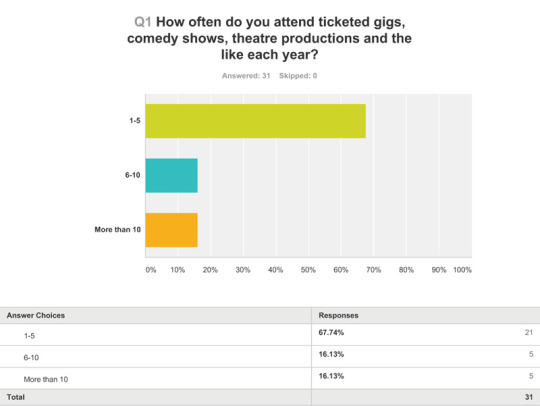

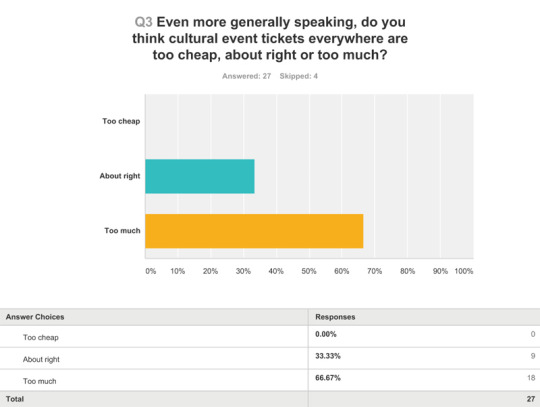
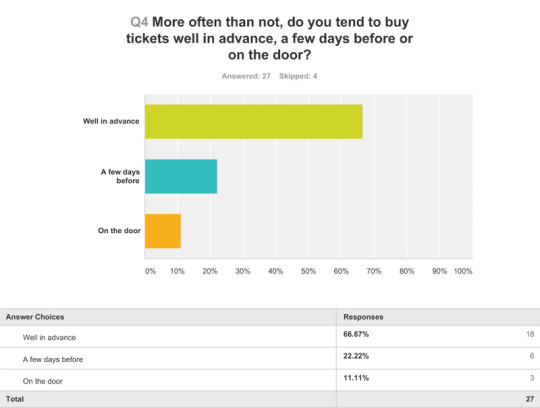
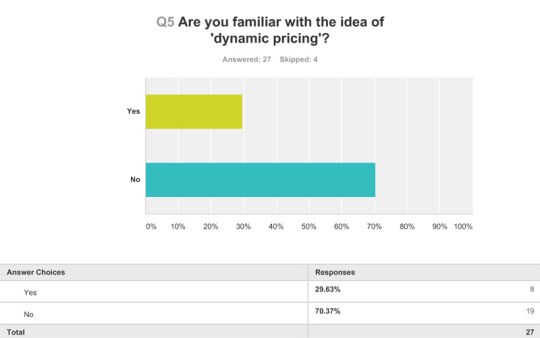
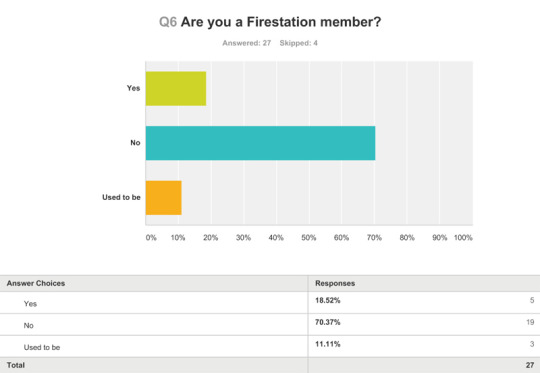


When you work for emergency services it's hard/impossible to book far in advance so we get penalised for not being able to book in advance.
I always miss the booking.
I think it’s a great idea!
Good luck with the trial. Ticketing needs disrupting!
#ticketing#neo-ticketing#the digital r&d fund for the arts#software#dynamic pricing#the firestation#Windsor#Arts#culture
0 notes
Link
An update on the project from Firestation Arts MD Dan Eastmond has been published on Arts Professional here.
"At The Firestation, Dan Eastmond has been experimenting with dynamic pricing. It’s still early days, but with rising income and no grumbling customers, the signs are positive."
#neo-ticketing#nesta#the firestation#ticketing#tech#box office#dynamic pricing#the digital r&d fund for the arts#monad#Windsor
0 notes
Link
A nice pick up on Neo-Ticketing from Windsor Observer - "AN INNOVATIVE new way to sell event tickets spearheaded by a Windsor arts centre has reached its halfway mark."
0 notes
Link
It's all about price perception.
0 notes
Text
Supa-Quick Stats, Phase One 'Rising Prices' (with comparison)
.tg {border-collapse:collapse;border-spacing:0;} .tg td{font-family:Arial, sans-serif;font-size:14px;padding:10px 5px;border-style:solid;border-width:1px;overflow:hidden;word-break:normal;} .tg th{font-family:Arial, sans-serif;font-size:14px;font-weight:normal;padding:10px 5px;border-style:solid;border-width:1px;overflow:hidden;word-break:normal;} .tg .tg-l9v6{font-weight:bold;font-family:Georgia, serif !important;;background-color:#c0c0c0} .tg .tg-n8hp{font-family:Georgia, serif !important;;background-color:#c0c0c0}
Sep-Dec 14
(Neo_Ticketing) May-Aug 14 Jan-May 14 Sep-Dec 13 # Events 25 49 78 64 Ave. Attendance 33 24 34 61 Ave Core Price* 9 - - - Ave Net Price 10.5 9.01 9.67 10.46
* The fixed price we would normally have set, and the price the dynamic prices ranges above and below.
Note; November & December 2013 included an unusually high number of sell out comedy shows, which has caused some distortion in the average attendance.
#tickets#box office#data#firestation arts and culture#the digital r&d fund for the arts#nesta#neo-ticketing#monad#pricing
0 notes
Photo
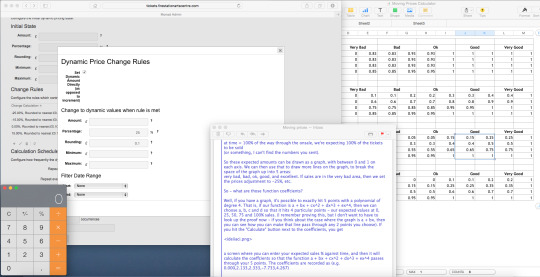
Just a regular day getting our Moving Prices events on sale!
0 notes
Text
Price Crash
Price Crash, the second pricing tool to roll out via Neo-Ticketing is now live..
Events are randomly selected to be included in Crash or not, the number & time of crashes is also selected randomly. Prices will crash by as much as 75% for just 30mins, with notifications going out via social media.
The idea is to generate a sense of urgency with the customer, to see if Price Crash encourages more followers via social media and whether has an overall positive impact on sales, income, engagement and perceived value.
#neo-ticketing#box office#ticketing#offers#software#social media#the firestation#Windsor#monad#the digital r&d fund for the arts
0 notes
Link
Thanks to Techagetheatre for picking up on the Neo-Ticketing project...
A new ticketing system has been given over £100,000 to fund development by the Arts Council. This pioneering technology has been spearheaded by the Firestation Centre in Windsor to allow more flexi...
0 notes
Text
First General Attitude Survey Results Are In
Interesting results from our first Neo-Ticketing survey. We’ll repeat these every season to see if any changes are apparent in either behaviour or attitudes.



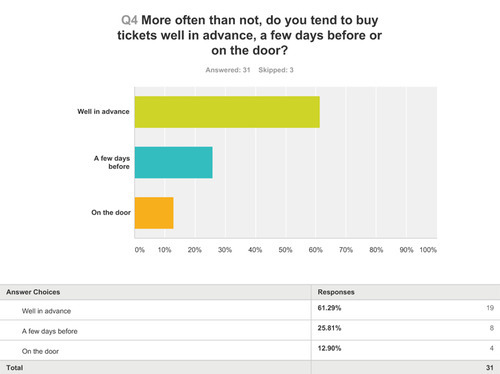

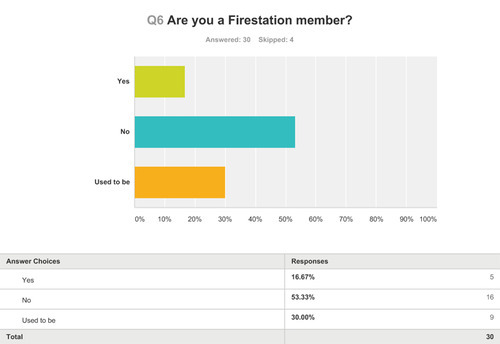


I think the maximum price should be displayed on the booking page, so people know how much they're saving by booking in advance.
No one likes to pay more than what is an honest cost. Everyone likes to pay less and save money. However, if it is worth it, money is well spent anyway... As long as prices are fair, who bothers about how much it is? If one wishes and can afford it, they come anyway. If they can't afford it, they might like that "last minute" reduction, but you can't plan events on that base, right? Don't know how this can help, just random thoughts about tickets and prices from someone that always has a tight budget and not many chanches to go to events even if I'd like to - but as I said, where there is a wish...
Ticket prices in sheds such as the O2 are extortionate, but smaller gigs are priced about right. Firestation events are well priced.
It appears this method increases revenue flow for the venue but would confuse customers and generate potenial ill feeling if the ticket price increased nearer a performance date. I do not like having to make a commitment to attend an event weeks in advance and would not bother to attend a performance if I knew I was going to be charged more for buying on the door....however if there was a discount on door ticket prices I would attend but would be aware tickets might sell out.
This survey is seeking the validate the decision making process that has been taking place for years by show promoters/buyers. Will they be able to stand the pressure of rising ticket prices as the show nears? Especially if their demand is light? I am interested in the analysis results.
#neo-ticketing#firestation#firestation arts#rhul#monad#windsor#nesta#the digital r&d fund for the arts#ticketing#box office#software
0 notes
Text
Help Us Out & Take our Quick Survey
It would help us out loads if you could take 2 mins (promise) to fill out this short survey ... and you could win a years free Firestation membership!!
// <![CDATA[ // ]]>
1 note
·
View note
Text
Web Feedback - 08.09.14
Surely we know the answer to this question?
It’s yes: smaller organisations can and do benefit from employing a variety of dynamic pricing tactics. Indeed we designed a pricing strategy very like that you describe two years ago... one of the earliest findings was don’t start too low!
#neoticketing#tickets#box office#sales#arts business#pricing#firestation arts#the digital r&d fund for the arts
0 notes